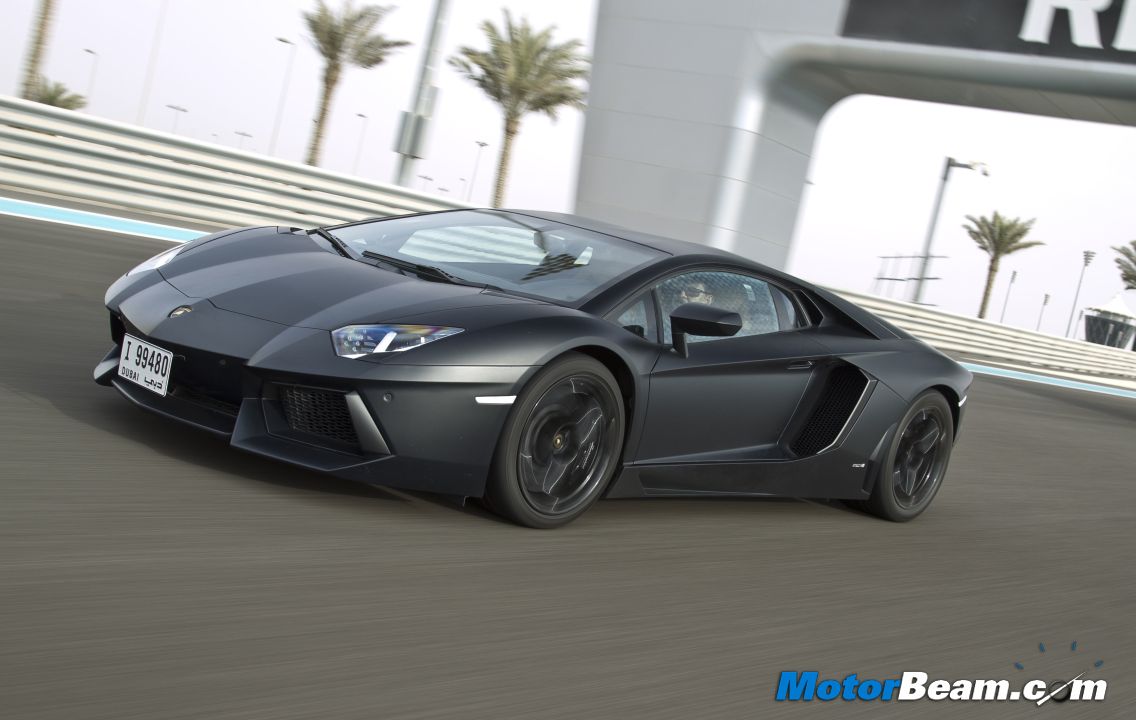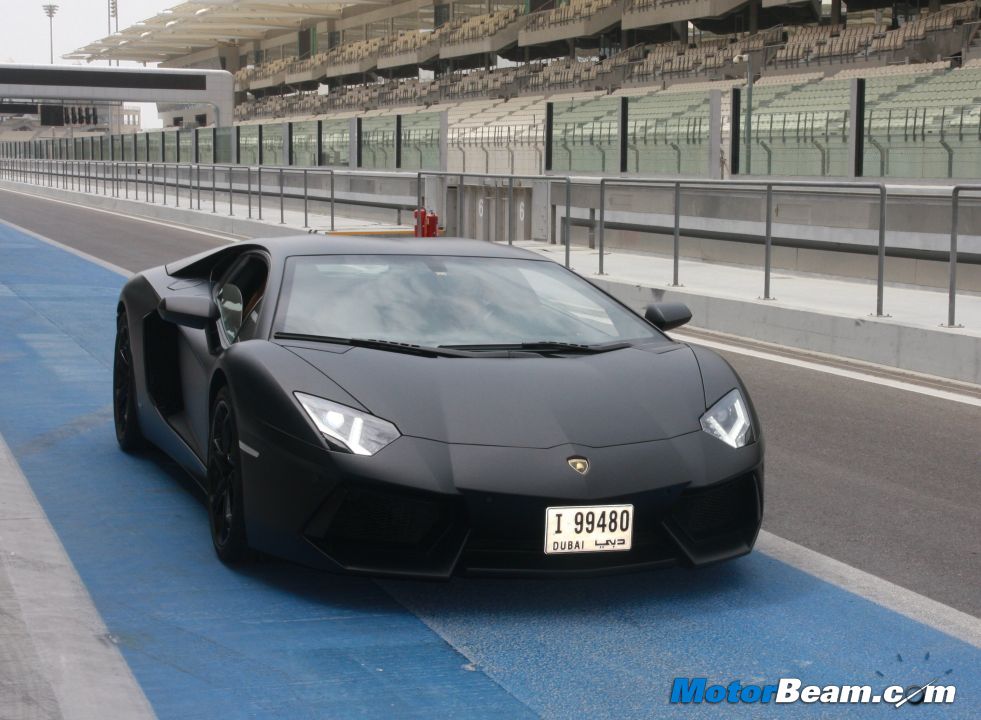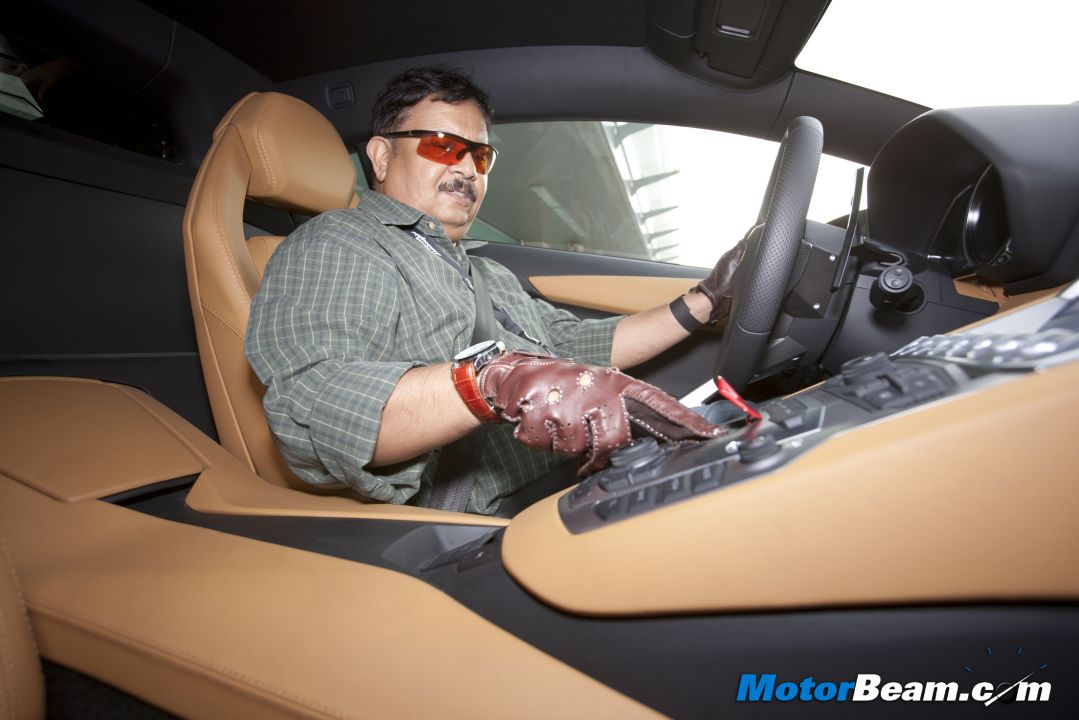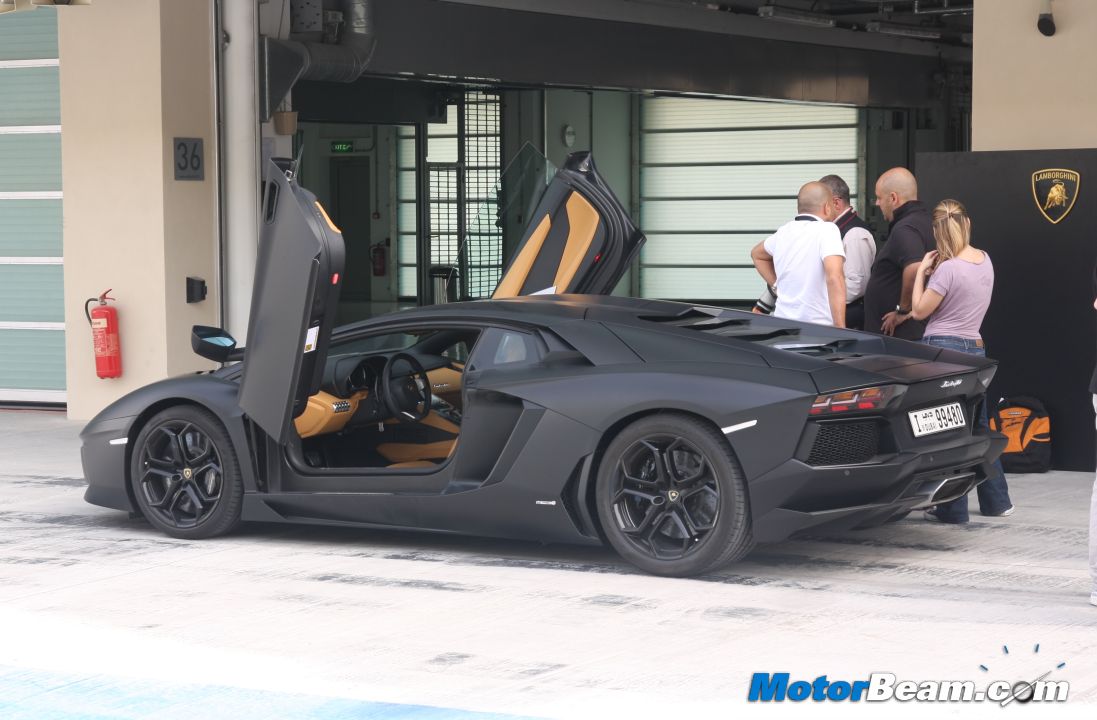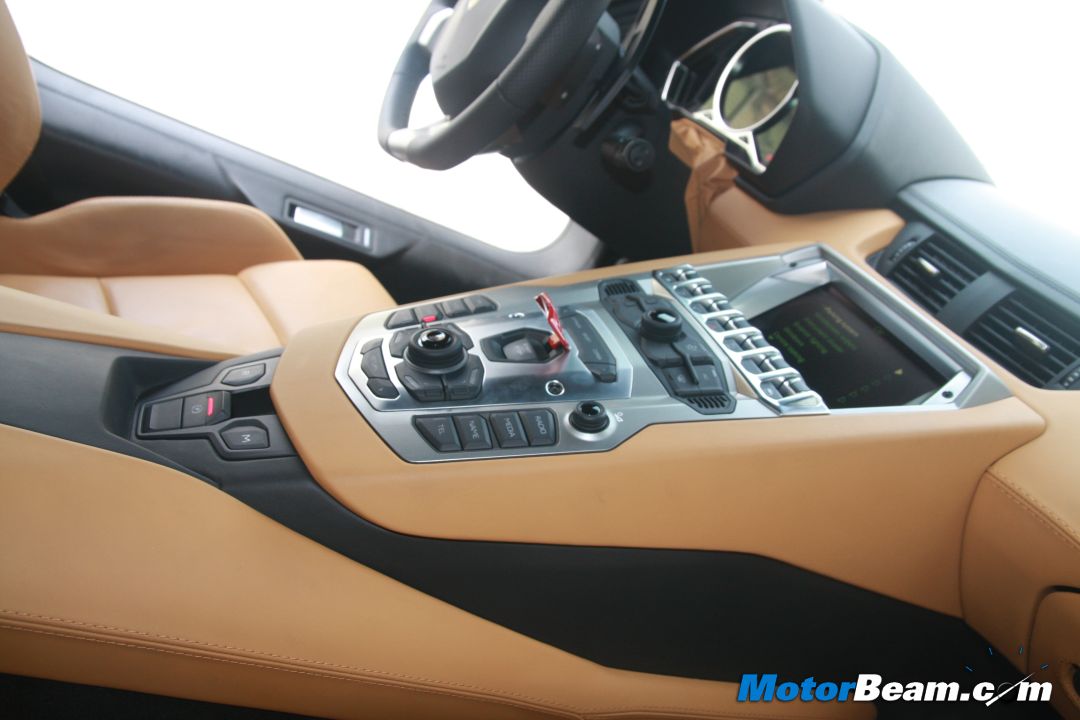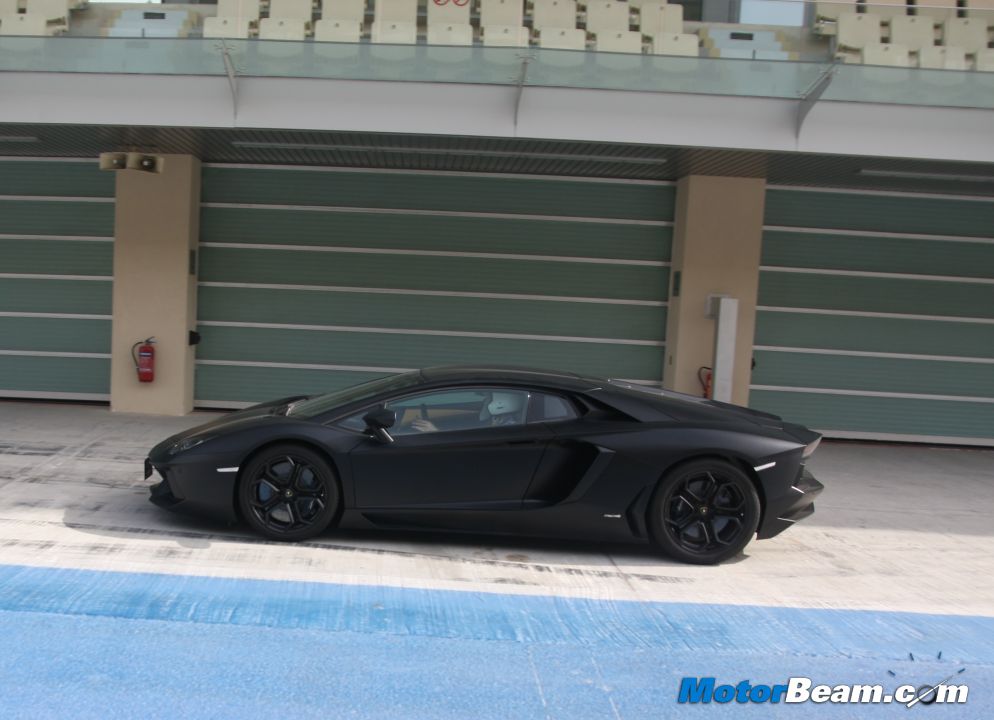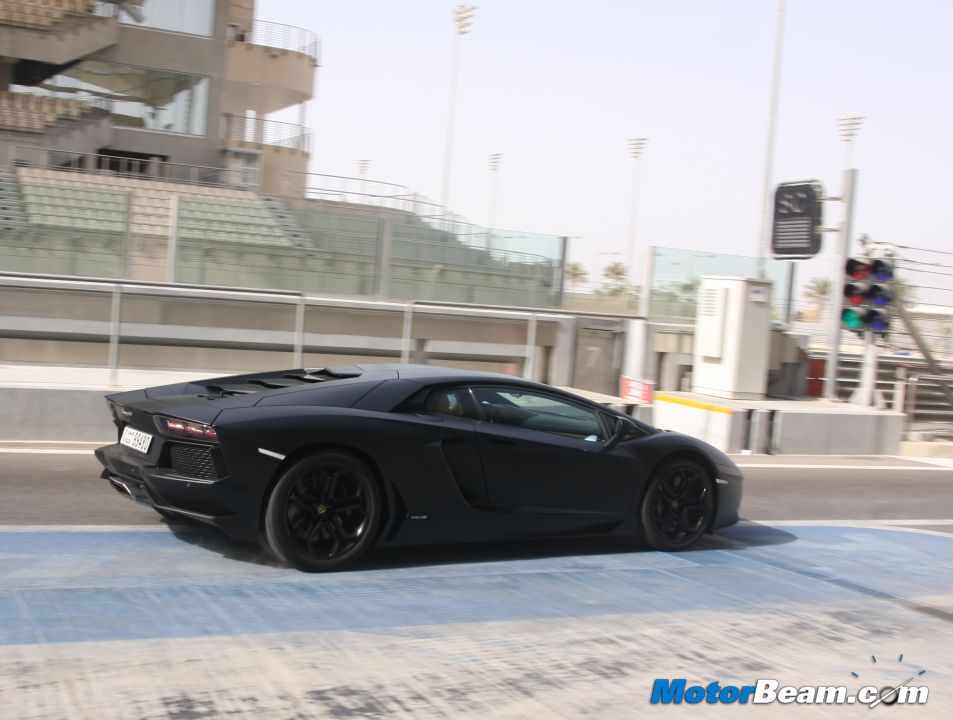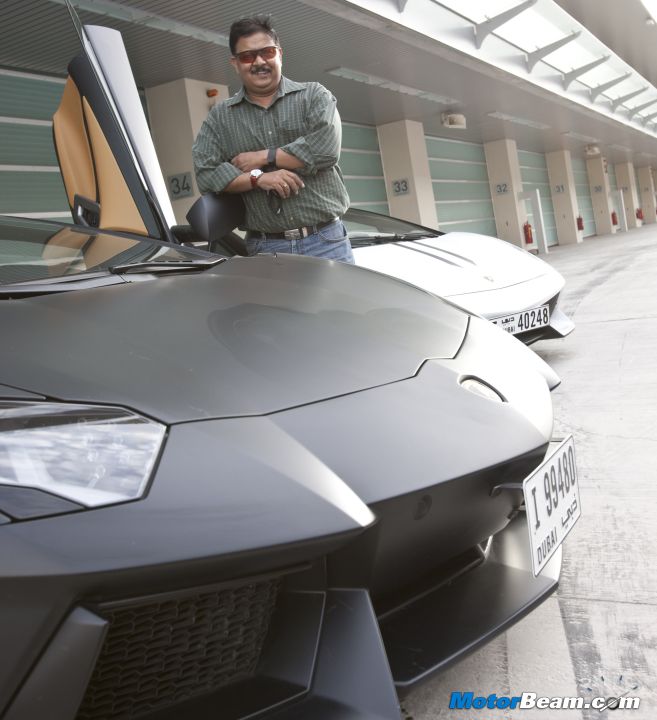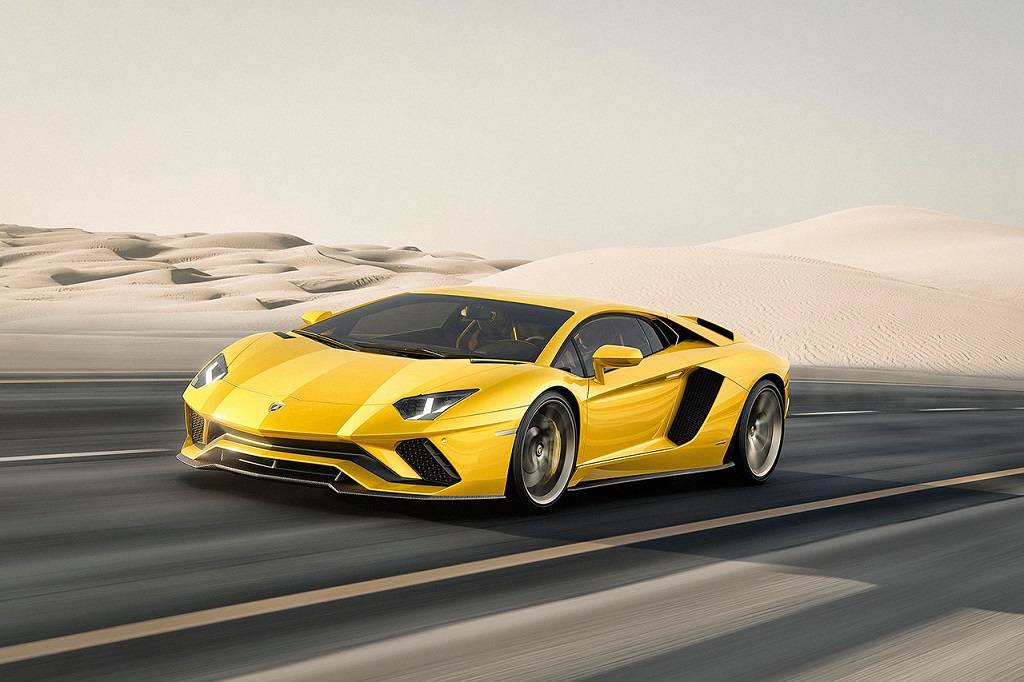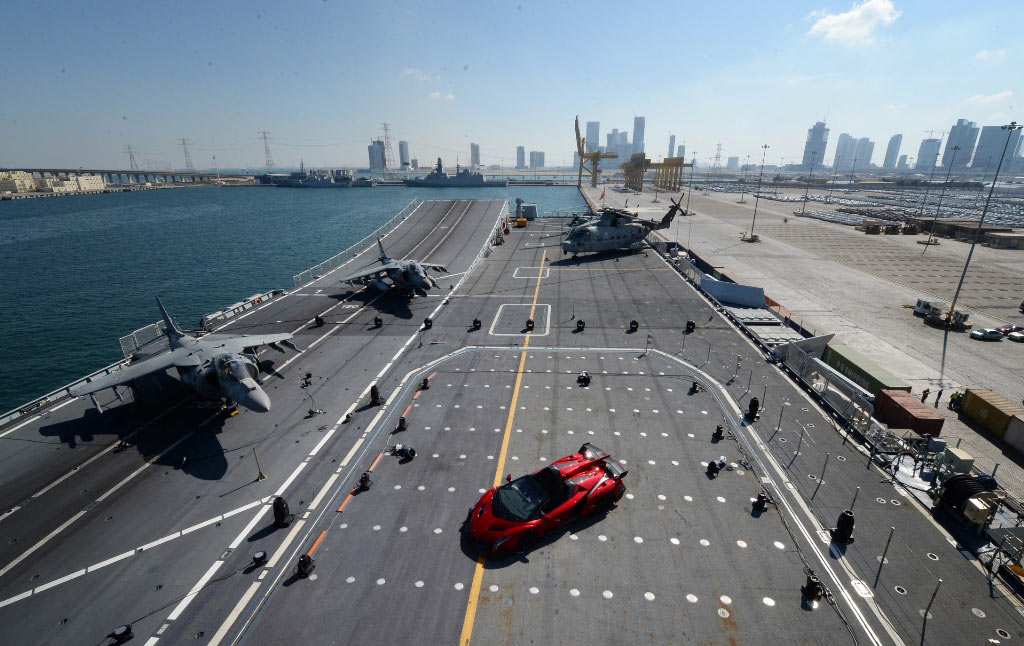Lamborghini Aventador Review
Lamborghini claims that the 2012 Aventador LP700-4 supercar is at least two generations ahead of any supercar currently on the market. MotorBeam spent some time with this car on the F1 Yas Marina track in Abu Dhabi in a bid to find out the truth.
Let’s begin with the name – Like previous Lamborghinis, the Aventador name was chosen for its symbolic connection to the world of fighting bulls, sharing a name with the legendary Aventador, a trophy-winning bull in the world of Spanish bullfighting. With the all-new 2012 Aventador LP700-4, Lamborghini says that it has rewritten another illustrious chapter for a befitting successor not only for the decade old Murcielago but also its mid-engined V12 models before it which represent the brand’s core heritage.
Svelte looks – Whether it’s bright metallic orange or stealthy matte black, the car’s design and stance is full of drama even when it’s at standstill. Low, squat and wide, there’s no arguing that this is the epitome of rear-engined supercars and its design and profile although is an extension of the Reventon concept, the Lamborghini Aventador does have a purpose in mind. A look at the details does reveal cues that marry form with function from several sources including aviation. I note also some late medieval themes in the spikes of Halbard axe in the front air dams and rear wings and the intersections of volumes in the large flap operated intakes. I specially liked the way designers have smartly integrated the industrial-size coolers on the sides with a rising body crease in the body and even the small design touches like the body colour edges to the massive lower air intakes and clever panel cuts complement the overall design. Safety equipment includes six front, thorax, head and knee airbags.
Cutting edge construction – In building this new car, the supercar maker had used all the tricks it has learnt from the race track, in composite materials, in engine design and in lightweight construction, safety and electronics. And never before has any super carmaker dared to incorporate such investments or innovations in a category of car that offers hyper-performance from its normally-aspirated engines and robitised transmissions at a time when most rivals are looking at downsizing displacement or cylinders and using forced feeding to boost power.
It had to be lightweight, strong and safe in order to meet the performance parameters. The car marginally bigger than the outgoing Murcielago and is 4,780mm long, 2,260mm wide and 1,700 mm high on a wheelbase of 2,700 mm and asymmetric track of 1,720 mm [front] and 1,700 mm [rear]. Lamborghini engineers designed a monocoque using patented technology like RTM (Resin Transfer Molding) in carbon fibre and extensively used aluminium in the chassis. As a result, the body is 150 per cent stiffer than the Murciélago and this is the first production application by Lamborghini in a car.
Engineering – The focal point definitely is the hyper performance all-new V12 which is mid-mounted. The reason for this it that Lamborghini engineers have taken a fresh look at the Bizzarrini-engineered original which has been around in its basic form since 1963 and modified it substantially. One of the engineering requirements was to allow the engine to rev more freely so that it can deliver its power more evenly across the rev-range. The new aluminium block engine (code named L539) is 40lb lighter and displaces 6.5-litre. It offers 690 bhp at 8,250rpm and maximum torque of 509lb ft at 5,500rpm. Compared with the outgoing V12, the bore and stroke is 95 x 76.4mm, meaning that L539 is a short stroke unit compared with the old unit’s long stroke 88 x 89mm. Lamborghini claims a “clean sheet” design and the dry sump configuration is redesigned so the crankshaft has been moved almost three inches upwards in the crankcase so the engine can be mounted lower in the frame to improve weight distribution for better handling. The weight-to-power ratio stands at only 2.25kg per hp and 0-100 km/h acceleration takes just 2.9 seconds and top speed is 350 km/h.
Although it is a faster, lighter, more powerful than the Murcièlago it replaces, it is also the cleanest, most economical and ecologically efficient car that Lamborghini has currently produced. Fuel consumption and CO2 emissions are down by around 20 per cent compared with its predecessor, despite the considerable increase in power (+8%).
The car’s robotised seven-speed manual transmission is made by Italian specialists, Graziano. Also known as the ISR transmission (Independent Shifting Rods) this unit uses integral plumbing in the casing to actuate shifts. Carbon-fibre synchronizers help activate the latest electro-hydraulically controlled Haldex dual clutches almost simultaneously so that one shifting rod is disengaging one gear and the second is engaging another. This arrangement help fastens shift times by up to 50 per cent and Lamborghini claims that in “Corsa” mode, they can be as low as 50 milliseconds. Drive is to all four wheels. Asymmetric Pirellis offer the contacts to ground. All-wheel drive system is now by Haldex IV with electronic torque split. Meanwhile, in the electronics’ department, the all-new architecture is designed to treat the engine and gearbox electronics as one unit and has a capability of handling up to half a billion inputs per second and Lamborghini claims it is faster than the eGear set-ups.
Formula One inspired suspension – The suspension package in this car is F1 inspired. The centre mount pushrod spring and damper concept means that the shocks and spring aren’t connected to the wheel mounts within the upper and lower A-arms, but transversely mounted inboard to the body shell with pushrods and relay levers transmitting lateral forces from the wheel to the shocks and springs. Brakes used are carbon-fiber ceramic ventilated discs with six pot calipers.
Top priority in aerodynamics – The way the car has been designed, is uses aerodynamic elements in an integrated format in the body shell. The underbody is flat and the rear spoiler is driver deployable and controlled. At standstill, the spoiler is flush with the rear of the vehicle and on the move it has two positions – the approach angle of 4 degrees is optimized for high speed and assists directional stability at the very top end of the spectrum. The tilt of 11 degrees, on the other hand, delivers considerably greater downforce at mid-range speeds, helping to optimize handling and stability. The car’s electronic sensors and CPU uses dynamic parameters to calculate for itself the most appropriate tilt angle. The car weighs 1,622kg and axle weight bias front to rear is 43:57 per cent. The real glass louvre over the engine, and the angular design is probably the most favourite detail in this car.
Classy interiors – Supercars in the past were never comfortable. You sat low, were surrounded by basic things and falling trim. In the Avantador, you still sit low in a new world ambience. Inside there’s luxury car package of leather-bound supportive, comfortable and electrically adjustable bucket seats. The windscreen rake is very high and you almost feel like sitting inside a hot rod with storage areas and a rather unusual instrument binnacle. The analogue part of the instruments are now replaced by a digital representation of a rev counter and ancillary instruments round the side. The expressively-designed interior also offers hi-tech features ranging from the TFT cockpit display with two types of displays. The central console is pretty wide [somewhat like the Porsche Panamera] with busy controls and the stop/start push button. Super cars are not usually friendly when it comes to hauling luggage. Under the bonnet of this one, there’s definitely an element of surprise as space has been carved out to accommodate a couple of aircraft hand-baggage sized cases.
Driving impressions – I’ve driven the Murciélago and for its time it was a good performer, but not without some inherent flaws. When compared with the Aventador, it was a bit raw and a little less disciplined since it didn’t have the dial-in precision of the successor. The Aventador is not just an adrenalin pumping machine, it is a far more disciplined and allows a driver to push to the limits of his ability and more. The car’s AWD technology has moved on, and so has the car moved closer to perfection and encourages the driver to accelerate through tight curves at speeds.
During the brief, as expected we were advised not turn off the electronic stability program, so when my turn comes late in the day, I adhere to the safety instructions strictly. Although visibility is predictably poor in the Aventador, especially at the rear, that’s not a real issue when you consider the comfortable riding position in the car and get used to it. Remove the bomb-release red cover and just push the starter button. With a short whine of the starter motor, the naturally-aspirated free-revving V12 screams into life. The Aventador’s exhaust soundtrack is markedly different than the V10 Gallardo — its whirring complete with a refined baffle blip. Engage gear electronically via push button [similar to Aston Martin’s with no gearshifter], release the brakes and we pulled out of the pits at 40km/h [maximum permitted] and gently joined onto the main circuit. One does feel a bit of over-stiffness in low-speed running, which I think is the pay-off for an “uncompromising” chassis which as I discovered later and several laps later has been tuned with ride quality in mind.
The new engine certainly delivers more performance and driveability, thanks to a more even power spread. But I am more interested in checking out the three transmission settings that are offered with appropriate adjustments to the torque transfer in the centre differential. I begin the first lap with Strada – here the gear changes are fast and smooth, like any sports car – I’d reckon would be good for day-to-day use and hence opt for the next option — the Sport. In this mode, the car’s electronics allows you to play, but progressively. At the same time I also noted that in this setting the car is also highly sensitive to tyres and likes to be turned in gently and progressively. The Corsa is the most extreme and with a good reason. This setting is a violent experience in gear shifting – even the best engineers can’t anything about it in these robotized set-ups, so one has to live with it and it’s best suited for track day experience, in my opinion.
What I also noted in slow speed corners that the car is quite sensitive to entry speed and dynamic mode, so it is quite possible in the experienced hands to be able to understeer or oversteer depending on how the throttle inputs are played and in what mode the chassis and gear settings were in. Fast exit traction was sensational, and in both Sport and Corsa mode, it’s was reasonable to prompt the car into a bit of oversteer without scaring the driver nanny’s too much. In high speed corners, one does feel the huge lateral grip, and the car changes direction beautifully to the driver input and the feedback is always stable and planted.
We’ve tested many cars at Yas Marina and the northern loop is our all-time favourite. Straightline acceleration and speed achieved is as you’d expect with 691bhp on tap, but that excellent traction sort of misleads the driver into thinking it’s not actually that fast. And it is. In fact, you’ll need to take time to adjust to how mind-bendingly quick it is especially when you chance a glance on the speedo. This specific stretch till now my personal best was 252km/h and with the Aventador I broke it by touching 263km/h! Of course, you need immense slowing power from the brakes at this level and this is where the large ventilated brakes come in handy. Not only they are powerful and strong, there was no sign of fading before or after the test car was driven.
Although a race track isn’t always the best test of a road car, but the Aventador proved more than up to the task, lapping all day with scores of drivers and just demanding fuel and some tyre replacements.
Verdict – Lamborghini’s latest baby answers several questions including the some of the complex ones especially when it comes to debating horsepower or torque, the typical argument being which is better? It’s been a never-ending debate among the critics and builders. Over-the-top thinking like this that made us fall in love with cars in the first place. The Aventador LP 700-4 is a petrolhead’s dreams made real and terms of pure supercar design, it doesn’t get better than this. Automobili Lamborghini has more than redefined the very pinnacle of the world super sports cars with a super formula that combines brutal power, outstanding lightweight engineering and jaw-dropping handling performance in a uniquely designed car that delivers an unparalleled driving experience.


